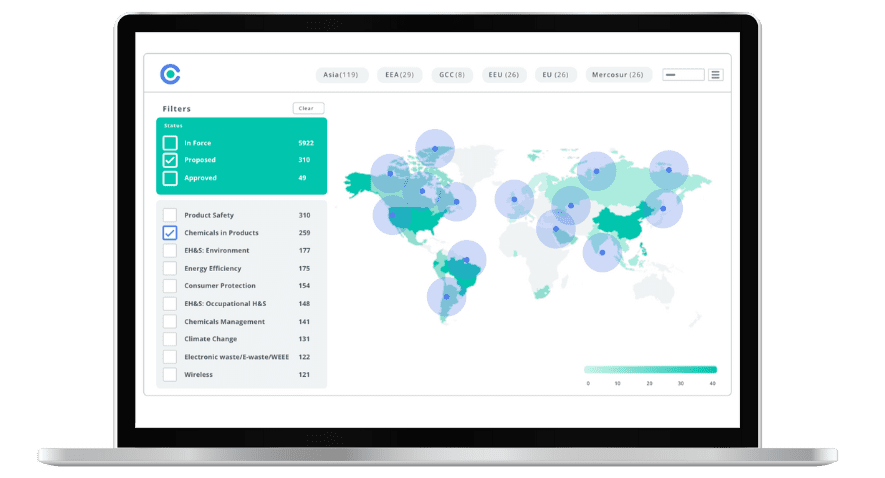
France Unveils Landmark Draft Orders Implementing its PFAS Restriction Law

This blog was originally posted on 26th August, 2025. Further regulatory developments may have occurred after publication. To keep up-to-date with the latest compliance news, sign up to our newsletter.
AUTHORED BY DIEUDONNÉ YMEDJI, SENIOR REGULATORY COMPLIANCE SPECIALIST & CÉLIA LE LIÈVRE, SENIOR REGULATORY COMPLIANCE SPECIALIST, COMPLIANCE & RISKS
On 7 August 2025, the French Ministry of Ecological Transition launched separate public consultations on two draft decrees implementing the so-called French PFAS Law No. 2025-188 of February 27, 2025.
The PFAS law has sparked a lot of debate and discussions. It is indeed a major milestone in that it prohibits the use of per- and polyfluoroalkyl substances (PFAS) in certain consumer products, including cosmetics, textile clothing, footwear and waterproofing agents. The ban will take effect as early as January 2026 and will be gradually expanded to cover all textile products placed on the market from January 1, 2030.
The first implementing proposal reflects France’s proactive strategy to eliminate PFAS in specific products, and reinforces its commitment to environmental and public health protection.
What is more, the law goes beyond banning PFAS in certain products by also addressing emissions from production facilities and industrial sites. In particular, it mandates the French government to develop a national strategy to gradually eliminate industrial aqueous discharges of PFAS within five years. The stated objective is to achieve near-zero PFAS emissions in industrial aqueous effluents by 2030. The second draft decree aims to clarify the scope and timeline of the progressive phase-out of PFAS in industrial effluents.
This blog distills down the content of these two draft implementation decrees, making it easier for your organization to understand the scope of PFAS restrictions and the drivers behind these changes.
Want to learn more about PFAS regulations and restrictions worldwide? Download a copy of our expert whitepapers ‘PFAS: United States Key Regulatory Developments‘ and ‘PFAS Under Pressure: Key Trends and Challenges Worldwide‘.
Understanding the Draft Decree Tightening Control on PFAS
Considering Law No. 2025-188, enacted in February 2025, which bans the production, import, export, and placing on the market of textiles, footwear, wax, and cosmetics containing PFAS, this draft implementing decree clarifies the prohibition regime for these substances in certain critical industrial uses. In this regard, it outlines the residual concentration threshold below which the prohibition on the use of PFAS in these products does not apply, as well as a narrow list of products exempted from the ban.
1. Scope of the Draft Implementing Measure
Article 1 of the draft decree introduces a new Chapter V to the regulatory section of the French Environmental Code. This chapter emphasizes the prohibition on placing certain products containing PFAS on the market. The ban applies to manufacturers, importers, exporters, and suppliers of textiles, footwear, wax, and cosmetics.
1.1 Definitions
New Article D.525-1 under this Chapter of the Code defines:
- In line with the widely adopted OECD definition of PFAS published in 2021, PFAS, as any substance containing at least one fully fluorinated methyl (CF3-) or methylene (-CF2-) carbon atom, with no attached hydrogen, chlorine, bromine or iodine atoms,
- Textiles, as any product that consists exclusively of textile fibers, irrespective of the mixing or assembly process used, as defined in Article 3 (1) (a) of Regulation (EU) No. 1007/2011,
- Placing on the market, as importing, supplying or making available, whether in return for payment or free of charge, to a third party.
1.2 Permitted Residual PFAS Concentrations
Article D.525-4 establishes the following three cumulative concentration thresholds to determine whether a product is subject to the ban:
- 25 parts per billion (ppb) for any PFAS measured by a targeted analysis, excluding polymers
- 250 ppb for the total PFAS measured as the sum of targeted analyses of PFAS, where appropriate, with prior degradation of precursors, but excluding polymers,
- 50 ppm for PFAS, including polymers.
The proposed thresholds aim to ensure that only unintentional trace amounts of PFAS are present in products. Unless exempt, any products exceeding these thresholds will be prohibited. Notably, these thresholds align with the standard detection limits of the analytical methods used for PFAS, and are also similar to the limits outlined in the draft generic restriction on PFAS, which is currently under review at the EU level. Additionally, the draft decree includes a provision to revise these thresholds in response to scientific and technical progress, making it a flexible framework that can adapt to new findings.
1.3 List of Products to Benefit from the Ban Exemptions
Not all products are subject to the ban. In accordance with Articles L. 524-1 I and II of the Environmental Code, as amended by Law No. 2025-188, the proposed Articles D.525-2 and D.525-3 to be inserted in the Code clarify the list of products that may not be subject to the prohibition from 01 January 2026 and 01 January 2030, respectively.
For the first batch, the proposal specifies that the exemption covers personal protective equipment as defined by EU Regulation 2016/425, including PPE intended for military and civil security forces and waterproofing agents used for the maintenance of PPE.
Regarding the exemptions from the all PFAS-containing textiles prohibition effective from 1 January 2030, new Article D.525-3 lists the following as out of the scope of the ban:
- Technical textiles for industrial purposes, such as high-performance membranes used for filtration or separation processes
- Textiles necessary for essential use or contributing to the exercise of national sovereignty, provided that no PFAS-free alternative exists
- Medical textiles, such as sanitary products essential for healthcare
2. Challenges and Implications for Businesses
The decree is scheduled to take effect immediately upon publication in the French Official Journal in December 2025. Businesses in the textile, wax, and cosmetics industries must act swiftly to avoid potential legal penalties, reputational harm, or loss of market access to France.
The following action steps are recommended:
- Review product lines and collaborate with suppliers to source materials that are free of PFAS or meet the new regulatory thresholds.
- Invest in research and development to create PFAS-free alternatives, thereby gaining a competitive advantage in a sustainability-focused market.
In summary, this French regulatory initiative represents a significant leap forward in the global effort to eliminate the unregulated use of PFAS in consumer products. By implementing strict limits and promoting the development of safer alternatives, this proposal not only aims to protect public health and the environment but also encourages innovation and a shift toward sustainability. Businesses facing the potential impact of these measures are urged to take immediate and proactive measures to adopt safer, more sustainable practices. By doing so, they can ensure compliance with the new regulations while also contributing to a healthier environment for future generations.
Progressive Phase-out of PFAS in Aqueous Industrial Effluents
1. Proposed Phase-out Trajectory for PFAS
In short, the first draft Order- issued pursuant to Article 2 of the PFAS Restriction Law – sets out a trajectory to reduce PFAS in industrial aqueous discharges by 70% (based on 2023 emission levels) by 27 February 2028. The ultimate goal is to achieve complete elimination of PFAS from all aqueous industrial effluents by February 2030.
This target is based on findings from an extensive research and analysis campaign carried out in 2023. The focus of this campaign was to detect the presence of PFAS in aqueous discharges from certain classified installations subject authorizations in accordance with the French nomenclature of ICPEs. It required listed facility operators to conduct monthly wastewater analyses over three consecutive months, focusing on the 20 PFAS identified in the Drinking Water Directive. The campaign was mandated by the Order of 20 June 2023 relating to the analysis of PFAS in industrial aqueous discharges. Findings showed that half of the industrial sites surveyed discharged at least one PFAS compound in their wastewater. Detected PFAS emissions did not only originate from industrial processes but were also found in the water supply of industrial sites.
2. Toward Comprehensive Control of PFAS Discharges in Industrial Sites
The draft decree seeks to address a gap in French environmental law, which currently lacks a general prohibition on PFAS discharges in aqueous industrial effluents.
To date, only one piece of legislation requires operators of authorized ICPEs to monitor a specific type of PFAS compound – known as PFOS – in their aqueous wastewater discharges. This legislation is the so-called RSDE Order of 24 August 2017 amending a former Order of February 1998. This Order sets a maximum concentration of 25 μg/l for PFOS in wastewater discharged into the natural environment. The installations subject to the above emission limit for PFOS are limited to ICPEs operating under the authorization regime (Article L. 512-1, Environmental Code). These include installations that create serious risks to health, public safety and the environment (e.g. waste incineration plants, hazardous chemical storage facilities, wastewater treatment plants etc).
Additional PFAS emission limits may be found in the BAT documents (Best Available Technologies) for certain types of authorized installations. In addition, the French State Council has also authorized Departmental Prefects to activate, as part of their special police power, the precautionary principle to restrict the release of PFAS from facilities operating in their jurisdictions ( Council of State, December 20, 2024, no. 475355 ; Council of State, May 24, 1993, Union of Chemical Industries, No. 113896).
However, despite sporadic efforts to control PFAS emissions from authorized ICPEs, France falls short of comprehensively addressing the broader environmental threats posed by PFAS. To address this gap, the draft Order states that the overall trajectory for the phase-out of PFAS substances could apply across all industrial sites. PFAS falling in scope are defined therein as PFAS substances containing at least one fully fluorinated methyl (–CF3) or methylene (–CF2) carbon atom, with no bonded hydrogen, chlorine, bromine, or iodine atoms.
3. Spotting Loopholes: Ambiguities in Site Coverage and Enforcement of PFAS Trajectory
The ambition of the legislator is clear: reduce and eliminate PFAS emissions in industrial wastewater. However, the draft decree lacks clarity regarding the scope of industrial sites concerned by the phase-out of PFAS in industrial effluents.
It remains to be seen how the trajectory will be enforced in practice. In particular, there is ambiguity around whether the terms “all industrial site” used in the recital of the draft Order intends to capture industrial sites outside the ICPE nomenclature. This wording suggests that all industrial sites discharging PFAS in their wastewater would be subject to the phase-out, even though they were not initially included in the 2023 measurement campaign. A national trajectory carries little weight if it is not supported by binding measures that require industrial sites to comply with specific emission limits. If the phase-out trajectory is to apply across “all industrial sites”, PFAS emission thresholds may need to be issued for a broader range of facilities, including ICPEs under declaration or registration regimes as well as unclassified industrial sites. Note that this draft Order is only the tip of the iceberg. Another flagship measure of the PFAS restriction law includes the introduction of a €100 fee for every 100 grams of PFAS discharged into water by authorized ICPEs. The specific list of PFAS substances subject to the fee will be established by government decree.
What’s Next?
The Ministry of Ecological Transition is inviting public comments on these two proposals until 5 September 2025. Interested parties can submit their feedback on the Ministry’s consultation pages below. Once enacted, the draft decrees could enter into force as soon as the day after their publication.
Consultation on Draft Order on Prevention of Risks Associated with PFAS in certain products
Stay Ahead Of Regulatory Changes in PFAS
Want to stay ahead of regulatory developments in PFAS?
Accelerate your ability to achieve, maintain & expand market access for all products in global markets with C2P – your key to unlocking market access, trusted by more than 300 of the world’s leading brands.
C2P is an enterprise SaaS platform providing everything you need in one place to achieve your business objectives by proving compliance in over 195 countries.
C2P is purpose-built to be tailored to your specific needs with comprehensive capabilities that enable enterprise-wide management of regulations, standards, requirements and evidence.
Add-on packages help accelerate market access through use-case-specific solutions, global regulatory content, a global team of subject matter experts and professional services.
- Accelerate time-to-market for products
- Reduce non-compliance risks that impact your ability to meet business goals and cause reputational damage
- Enable business continuity by digitizing your compliance process and building corporate memory
- Improve efficiency and enable your team to focus on business critical initiatives rather than manual tasks
- Save time with access to Compliance & Risks’ extensive Knowledge Partner network

Product Compliance in Fashion & Textiles: Navigating New Rules on Labelling, Ecodesign & Environmental Claims
In this webinar, you will gain practical insights into how regulations are changing across labeling, environmental claims, product safety, and ecodesign, as well as which horizontal frameworks now apply to textile and apparel products.


